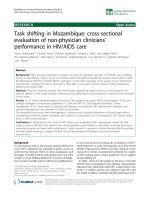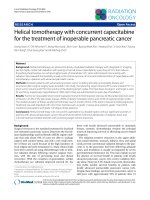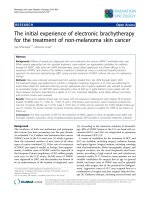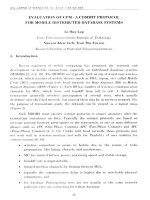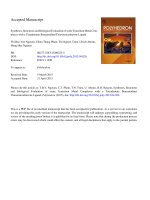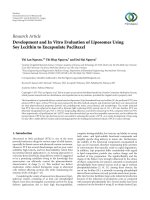Evaluation of results of conformal concurrent chemoradiotherapy at the dose of 50.5 Gy in the treatment of non surgical esophageal cancer at 103 Military Hospital
Bạn đang xem bản rút gọn của tài liệu. Xem và tải ngay bản đầy đủ của tài liệu tại đây (294.4 KB, 8 trang )
T¹p chÝ y - d−îc häc qu©n sù sè 1-2019
EVALUATION OF RESULTS OF CONFORMAL CONCURRENT
CHEMORADIOTHERAPY AT THE DOSE OF 50.5 Gy
IN THE TREATMENT OF NON-SURGICAL ESOPHAGEAL
CANCER AT 103 MILITARY HOSPITAL
Tran Viet Tien1; Tran Van Ton1; Pham Thi Hoan1
SUMMARY
Objectives: To evaluate the efficacy and adverse effects of conformal concurrent chemoradiotherapy
at the dose of 50.4 Gy in non-surgical esophageal cancer patient at 103 Military Hospital.
Subjects and methods: A cross-sectional and prospective study was performed in 66 patients
who were diagnosed with non-surgical esophageal cancer at 103 Military Hospital from January
2015 to June 2018. Results: The complete response rate was 34.85%, the partial response
rate was 45.45%. The overall survival rate after 18 months was 74.24%, the survival rate after
18 months with stages II, III and IV was 100%, 80.43%, 55.56%, respectively; common adverse
effects were eosinophilia I (84.85%), uncommon adverse effects were complications of pneumonia
(6.06%), esophageal fistula (4.54%). Conclusion: Conformal concurrent chemoradiotherapy at the
dose of 50.4 Gy and PF therapy significantly improves clinical symptoms, prolongs survival time,
reduce complications and adverse effects.
* Keywords: Esophageal cancer; Concurrent chemoradiotherapy; 3D conformal radiation therapy.
INTRODUCTION
According to Globocan 2012, esophageal
cancer is the eighth most common cancer
in the world and ranks third in gastrointestinal
cancers after stomach cancer and colon
cancer [3].
For non-surgical esophageal cancer,
concurrent chemoradiotherapy is highly
effective in significantly improving the
clinical symptoms and prolonging the
patient's life time. In Vietnam, there are
several studies about chemoradiotherapy
in the treatment of esophageal cancer,
such as the study of Han Thanh Binh in
2004, Nguyen Duc Loi in 2015, but these
studies were limited to 2D radiotherapy
and 60 Gy high dose radiation therapy
[1, 2].
Minsky's RTOG 94-05 in 2002 showed
no difference in median survival (median
survival 13 months vs. 18 months), overall
survival (OS) after 2 years (31% vs. 40%)
between the 65 Gy high dose
radiotherapy group and the 50.4 Gy
radiotherapy group while the adverse
effects in the 65 Gy radiation group were
significantly higher than the 50.4 Gy group
(10% vs. 2%) [4].
Additionally, the introduction of 3D
dimensional conformal radiation therapy
(3D CRT) with the use of multileaf collimator
MLC allows the creation of radiographic
fields according to the shape of the tumor;
1. 103 Military Hospital
Corresponding authors: Tran Van Ton ()
Date received: 20/10/2018
Date accepted: 03/12/2018
131
T¹p chÝ y - d−îc häc qu©n sù sè 1-2019
this helps to focus high doses at the tumor
and minimize the harm to the surrounding
health tissues.
This is a modern technique being
deployed in some radiotherapy centers in
the country. Based on these issues, we
propose the implementation of the project
with the objects: Evaluating the efficacy
and adverse effects of conformal concurrent
chemoradiotherapy at the dose of 50.4 Gy
in treatment of non-surgical esophageal
cancer.
SUBJECTS AND METHODS
1. Subjects.
A cross-sectional and prospective
study was performed on 66 patients who
were diagnosed with non-surgical esophageal
cancer at 103 Military Hospital from January
2015 to June 2018.
* Inclusion criteria:
- Patients diagnosed with stage II, III and
IV esophageal cancer, according to AJCC7
classification, have no indication of surgery.
- Patient refused surgery
* Exclusion criteria:
- Patients with a performance status
(PS) > 3.
- Patients with severe combined diseases.
- Patient refused to participate in the
study.
2. Methods.
Patients who met the study criteria will
receive concurrent chemoradiotherapy.
Chemotherapy of PF regimen (cisplatin
75 mg/m2 body area, intravenous infusion
on the first day; 750 mg5 FU/m2 body
area, intravenous on 1st - 4th day), cycle of
28 days x 04 cycles, of which 2 cycles of
concurrent chemoradiotherapy followed
by 2 cycles of chemotherapy alone. 3D
conformal radiation therapy with a total
dose of 50.4 Gy in tumors and lymph
nodes, 1.8 Gy/day, 5 days/week. Patients
were then evaluated for clinical response,
according to RECIST, evaluating the overall
survival rate after 6 months, 12 months,
and 18 months; stage-dependent survival
rate and adverse effects. The data was
processed by SPSS software version 20.0
RESULTS AND DISCUSSION
Diagram 1: Clinical symptoms before treatment.
132
T¹p chÝ y - d−îc häc qu©n sù sè 1-2019
Dysphagia was the most common symptom with a percentage of 90.9%, chest pain
60.61%, weight loss 30.3%, vomiting 33.33%, lymphadenopathy 21.21%, hoarseness
4.55%. The incidence of dysphagia was similar to that in the study of some authors in
Vietnam and other countries. According to the study by Han Thanh Binh in 2004,
the percentage of dysphagia was 99.2% [1]; in the study by Nguyen Duc Loi in 2015,
this figure was 87.9% [2]; and Theodore’s in 2000, it was 96% [5].
Diagram 2: Classification of dysphagia before treatment.
The classification of dysphagia was mainly grade 2 (39.4%), which means dysphagia
to semi-solid food, ability to eat porridge, milk; and grade 1 (dysphagia to solid food)
accounted for 30.3%; for grade 3 (dysphagia to liquid food), the rate was 9.1%; as for
grade 4 (complete dysphagia), it was 12.1%. Patients in our study mainly came from rural
areas with low education and the examination time was not early so the percentage of
grade 3 and 4 of dysphagia was higher than that in Nguyen Duc Loi’s study (2015) by
8.3% and 0%, respectively [2].
* AJCC 7 classification for the stage of injury:
Patients in our study were mainly in stages III and IV, which was the period of no
longer indicative of surgery; of which, 69.69% of patients were in stage III, mainly in
stage IIIC with 48.48% (32 patients); stage IIIA accounts for 21.21% (14 patients);
27.28% of patients (18 patients) were in stage IV. In the study by Deren (1989), the
percentage of patients with stage III was 73.9% [6], in the study by Nguyen Duc Loi
(2015), it was 86.4% [2]. Particularly in this study, we had 2 patients in stage IIB,
accounting for 3.03% who had indication of surgery but they refused and had a desire
to undergo chemoradiotherapy.
133
T¹p chÝ y - d−îc häc qu©n sù sè 1-2019
Diagram 3: Changes in clinical symptoms before and after treatment.
The percentage of patients with dysphagia, weight loss, chest pain, nausea, vomiting,
lymph nodes, hoarseness before treatment were 90.90%, 30.33%, 60.61%, 33.33%,
21.21%, 4.54% and after treatment were respectively 30.33%, 25.75%, 25.75%, 10.00%,
9.09%, 1.51%. The results showed that concurrent chemoradiotherapy significantly
improved clinical symptoms, especially dysphagia (decreased from 90.9% pre-treatment
to 30.33%) and chest pain (decreased from 60%, 61% to 25.75%).
Diagram 4: Changes in pevalence rates of dysphagia before and after treatment.
134
T¹p chÝ y - d−îc häc qu©n sù sè 1-2019
The most obvious clinical manifestation
of the treatment response was a change
in dysphagia status, after treatment, the
percentage of grade 0 dysphagia increased
from 9% to 69.69%, along with that, the
percentage of grade 2 and grade 3
dysphagia reduced from 30.3% and 39%
before treatment to 10.61% and 12.12%
after treatment; grade 3 decreased from
9.10% to 3.04%; grade 4 decreased from
12.10% to 4.54%.
* Treatment response on CT according
to RECIST 1.1:
According to RECIST: The complete
response percentage was 34.85%
(23 patients), the partial response
percentage was 45.45% (30 patients).
The percentage of stable and progressive
disease was 10.61% (7 patients) and 9.09%
(6 patients), respectively. This result was
similar to some studies in Vietnam and
foreign countries. According to the study
by Nguyen Duc Loi (2015), using 60 Gy
radiation therapy, the complete response
percentage was 31.1%, the partial
response percentage was 53.8%, the
percentage of disease that was stable
was 12.9% and progressive was 2.2% [2].
According to Kaosu Ishida (2004), study
on concurrent chemoradiotherapy with the
regimen of CF + 60 Gy radiation, results
showed that the percentage of complete
and partial response was 68.2%, stable
and progressive disease was 31.8% [7].
This suggests that treatment response at
a dose of 50.4 Gy is equivalent to 60 Gy
radiation therapy.
* The overall survival rate:
The overall survival rate after 6 months,
12 months, 18 months was 95.45%
(63 patients), 95.45% (63 patients) and
74.24% (49 patients), respectively. According
to Nguyen Duc Loi, concurrent
chemoradiotherapy using a dose of
60 Gy, the overall survival rate 12 months,
18 months was 92.7%, 67.6%, respectively
[2]. According to Han Thanh Binh (2004),
use of radiation alone, the overall survival
rate of 12 months, 24 months was 20.9%
and 9.3% [1]. This indicated that concurrent
chemoradiotherapy had a statistically
significant overall survival rate of 12 months
compared with radiotherapy alone. The
overall survival rate after 12 months and
18 months in our study using 50.4 Gy
doses was similar to Nguyen Duc Loi’s
findings with a dose of 60 Gy.
Table 1: Stage-dependent survival rate.
Overall survival time
Stage
6 months
12 months
18 months
n
%
n
%
n
%
II (2 patients)
2
100
2
100
2
100
III (46 patients)
46
100
46
100
37
80.43
IV (18 patients)
15
83.33
15
83.33
10
55.56
According to Nguyen Duc Loi (2015), concurrent chemoradiotherapy with a dose of
60 Gy, survival rate after 12 months and 18 months of phase III was 93.4% and 70.9%;
phase IV was 88.9% and 48.1% [2].
135
T¹p chÝ y - d−îc häc qu©n sù sè 1-2019
Table 2: Adversed effect on hematology.
Leukopenia
classification
Number of
patient (n = 66)
Percentage
(%)
Grade I
56
84.85
Grade II
6
9.09
Grade III
4
6.06
Grade IV
0
0.00
The most common adverse effects in
the hematological system were leukopenia,
grade 1, grade 2, grade 3, which was
84.85%, 9.09%, 6.06%, respectively,
mainly in grade 1 and 2, without affecting
the treatment. There were no patients
with grade 4 leukopenia. These were
low-grade adverted effects and can be
controlled in the course of treatment.
* Complications on other organs:
Pneumonia occured at 6.06% (4 patients)
with interstitial pneumonitis. These cases
usually recovered after high doses of
topical corticosteroids combined with broad
spectrum antibiotics. In this study, 3 cases
of esophageal fistula during treatment,
accounting for 4.54%. Esophageal fistula
occurred at the beginning of radiotherapy
and we recorded as complications related
to the treatment. Ishikura S (2005) studied
concurrent chemoradiotherapy with a dose
of 50.4 Gy, this figure was 12% [8].
CONCLUSION
For patients with no-longer-prescribed
surgery, concurrent chemoradiotherapy,
chemotherapy of PF and 3D conformal
radiation therapy at the dose of 50.4 Gy
136
significantly improved both subjective and
objective symptoms, enhance the quality
of life and extend the life span.
The percentage of dysphagia, chest
pain, weight loss before treatment were
90.9%, 60.61% and 30.33%, respectively;
after treatment, they were 30.33%, 25.75%
and 13.63%, respectively. Partial and
complete response rates on CT imaging
according to RECIST classification was
45.45% and 34.85%; the percentage of
disease stability and progression were
10.61% and 9.09%. The overall survival
rate after 6 months, 12 months and
18 months were 95.45%, 95.45% and
74.24%, respectively. Stage-dependent
survival rate after 18 months with stages
III and IV were 80.43%; 55.56%, respectively.
Common complication was leukopenia
grade I (84.85%), uncommon complications
were pneumonia (6.06%) and esophageal
fistula (4.54%).
REFERENCES
1. Han Thanh Binh. Commentary on the
clinical characteristics, histopathology and
outcome of the treatment of esophageal
carcinoma in K Hospital in the period of 1998 2004. Graduation Thesis of Resident Doctor.
Hanoi Medical University. 2004.
2. Nguyen Duc Loi. Evaluate the efficacy of
concurrent chemoradiotherapy and some
predictors of stage III and IV esophageal
carcinoma at K hHspital. Medical PhD Thesis.
Hanoi Medical University. 2015.
3. J. Ferlay, I. Soerjomataram, R. Dikshit.
Cancer incidence and mortality worldwide:
Sources, methods and major patterns in
T¹p chÝ y - d−îc häc qu©n sù sè 1-2019
GLOBOCAN 2012. J Cancer. 2015, 136 (5),
E359-386.
Analysis of 869 patients. Radiat Oncol
Biol Phys. 1989, 16. pp.329-334.
4. Minsky B.D, Pajak T.F, Ginsberg R.J
et al. INT 0123 (Radiation Therapy Oncology
Group 94-05) phase III trial of combinedmodality therapy for esophageal cancer: Highdose versus standard-dose radiation therapy.
J Clin Oncol. 2002, 20 (5). pp.1167-1674.
7. Ishida K, Ando N, Yamamoto S et al.
Phase II study of cisplatin and 5 Fu with
concurrent radiotherapy in advanced squamous
cell carcinoma of esophagus: A Japan
Esophageal Oncology Group. Jpn J Clin Oncol.
2004, pp.615-619.
5. Theodore L.P, Bruce D.M et al.
Gastrointestinal tumors. Textbook of Radiation
Oncol. 2th Ed. 2000, po.601-623.
6. Deren S. Ten year follow-up of esophageal
cancer treated by radical radiotherapy:
8. Ishikura S, Ohtsu A, Shirao K, et al.
A phase I/II study of nedaplatin and
5 fluorouracil with concurrent radiotherapy
in patients with T4 esophageal cancer. Japan
Clinical Oncology Group trial 9908. 2005,
pp.133-137.
137
T¹p chÝ y - d−îc häc qu©n sù sè 1-2019
2
